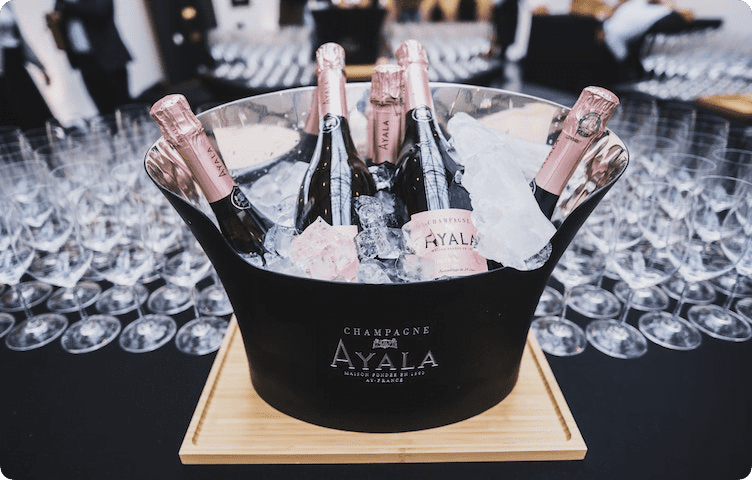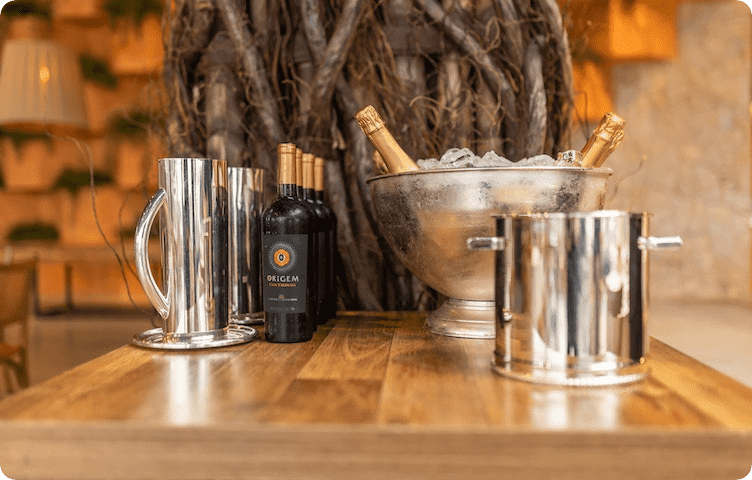The taste and aroma of sparkling wines are fully revealed if the drink is pre-cooled. The bottles can be refrigerated, but they will heat up quickly when left in the air. To keep wine cold longer, it is recommended to use a champagne bucket , also often called a cooler. This exquisite accessory not only ensures the desired serving temperature, but also decorates the table.
What is a bucket for?
Sparkling wines are usually served chilled to a temperature of + 8-10° C. Under this condition, the alcohol does not evaporate too quickly, allowing you to appreciate the aromatic bouquet. Carbon dioxide bubbles play beautifully only in chilled champagne.

But in wine glasses, the drink quickly becomes warm, so wine experts advise cooling the wine 1-2 degrees below the recommended temperature. To do this, you can place the bottle in the refrigerator 2-3 hours before serving. But as soon as you take it out, the wine begins to heat up.
Bottles are cooled much more efficiently in a special bucket filled with a mixture of ice and water. This cylindrical metal vessel is traditionally used to serve champagne in expensive restaurants and private homes with elegant interiors. For ease of carrying, buckets are often equipped with handles.
A container for cooling champagne can be of any shape, size and volume. The most practical to use are models with a volume of 2.5 to 4 liters .
Before serving, fill the bucket a third with cold water. Then add ice cubes, 10 pieces per bottle.
Do not put too much ice - if wines are cooled too much, especially sweet ones, they will lose their taste. As it melts, add new cubes. You can also use crushed ice, using 20 crushed cubes per bucket. In ice water, champagne becomes cold in about half an hour.
History of appearance and culture of use
It is known that already in the 6th century BC. At feasts in Ancient Greece, they drank mead and wine chilled in special vessels - kraters. This double-walled bronze vessel kept drinks cool even in the summer heat.
The tradition of drinking chilled wine continued into the Middle Ages. Since there were no refrigerators, people mined natural ice and stored it in cellars and deep pits covered with straw. During the warm season, ice was taken from storage and delivered to the homes of wealthy aristocrats as quickly as possible. Ice was not available to ordinary people because it was very expensive.
The need to keep drinks cool gave rise to a whole range of tableware - from ceramic sinks to silver containers reminiscent of a modern champagne bucket.
In the 17th and 18th centuries, vases made of expensive porcelain filled with ice served as coolers. The French nobility had special cooler tables with zinc cavities in which bottles were placed in salt water or metal buckets with ice.
The simplest model of a wine cooler began to be used in England in the 19th century. This was a decorative ice bucket, most often made of silver. Not a single dinner party in a rich house was complete without this vessel. Later the English tradition spread to other countries.

According to the rules of table etiquette, a bucket of champagne is placed not in the center of the table, but closer to the edge or on a separate serving table. The container is placed on a special stand or flat plate. There should be a small plate nearby for the cork and foil. The bottle is placed in ice so that guests can see the name.
In addition to champagne, other wines can be served in a bucket. It is important to maintain the temperature appropriate for the type of drink:
- red – from +16 to 18° C;
- Beaujolais, pinot noir – + 13-15° C;
- dry white – + 8-10° C;
- white semi-sweet – + 11-13° C;
- pink – + 9-12° C.
 For sparkling wines, the water level in the bucket should be higher than for other varieties.
For sparkling wines, the water level in the bucket should be higher than for other varieties.Varieties
The first containers for cooling wine bottles, which appeared in the 19th century, were a simple bucket. In high society, vessels made of silver and Sevres porcelain were used. Nowadays, the cooler has become a design object that should attract the attention of guests. Manufacturers use ceramics, tempered glass, plastic and even ivory for production. The most common material is stainless steel .

There are four types of buckets:
classic - resembles a truncated cone or box in shape, expanding upward. Equipped with a bow or two handles. Holds from 1 to 4 bottles. Designer models are decorated with cast patterns, embossing, and logos;
with additional parts - supplied with a removable stand and lid. Sometimes it comes complete with a floor stand up to 1 m high. There are special models for use in the bathroom, with hooks for attaching to the edge of the bathtub;
bowl - resembles the shape of a vase or goblet with a high stem. Holds 1-10 wine bottles. This type of bucket is often made of porcelain, glass, non-ferrous metals, and decorated with patterns, gilding, and decorative elements. Used for large celebrations, where it creates an atmosphere of luxury;
champagne table - looks like a low table made of glass or metal, in which the place of the table top is occupied by a deep container with ice.
Modern champagne vessels are equipped with electronic controls that support different temperature conditions. The device automatically chills multiple bottles without the need to replace ice cubes.
How to choose a good bucket
A champagne bucket enhances the beauty of the table setting. But you should not choose this piece of utensils only by its external design. The cooler should match the theme of the feast. For a wedding or anniversary, choose a product with an elegant design; for a business reception, a classic bucket without decoration is more appropriate.
When purchasing, it is important to consider three more characteristics:
- material – for a private collection you can purchase a model made of porcelain, crystal , silver. Restaurants typically use durable stainless steel products;
- size – at large celebrations, bowls designed for 6-10 bottles are used. For home use, a bucket for 1-2 bottles is suitable;
- additional details - a model with handles or a bow is more convenient for serving. If the cooler is intended for a restaurant, look for sets with a high stand.
For those who are buying a champagne bucket for the first time, it is recommended to choose products from well-known brands. Products from Prohotel , ILSA , Eternum , Paderno receive good reviews.
















































/https%3A%2F%2Fcomplexbar.com%2Fimages%2Fblog%2F244%2Fvedro-dlya-shampan.jpg)
/https%3A%2F%2Fcomplexbar.com%2Fimages%2Fblog%2F245%2Fskov_glavn.jpeg)
/https%3A%2F%2Fcomplexbar.com%2Fimages%2Fblog%2F245%2Fhaiboli.jpg)
/https%3A%2F%2Fcomplexbar.com%2Fimages%2Fblog%2F245%2Fvilki-na-stole-752x480.jpeg)
/https%3A%2F%2Fcomplexbar.com%2Fimages%2Fblog%2F246%2F2024-04-09_17.22.54.jpg)
/https%3A%2F%2Fcomplexbar.com%2Fimages%2Fblog%2F246%2F2024-04-09_17.22.47.jpg)
/https%3A%2F%2Fcomplexbar.com%2Fimages%2Fblog%2F246%2FCODE_anons_foamydrops_752%D1%85480_eng.jpg)
/https%3A%2F%2Fcomplexbar.com%2Fimages%2Fblog%2F246%2FAlina_752%D1%85480_eng.jpg)
/https%3A%2F%2Fcomplexbar.com%2Fimages%2Fblog%2F246%2F2024-04-09_17.23.22.jpg)
/https%3A%2F%2Fcomplexbar.com%2Fimages%2Fblog%2F246%2F2024-04-09_17.23.28.jpg)
/https%3A%2F%2Fcomplexbar.com%2Fimages%2Fblog%2F246%2F2024-04-09_17.23.35.jpg)
/https%3A%2F%2Fcomplexbar.com%2Fimages%2Fblog%2F246%2Fdrinksome_752%D1%85480_eng.jpg)
/https%3A%2F%2Fcomplexbar.com%2Fimages%2Fblog%2F246%2Fnude_752%D1%85480_eng.jpg)
/https%3A%2F%2Fcomplexbar.com%2Fimages%2Fblog%2F246%2F752%D1%85480_eng__1_.jpg)
/https%3A%2F%2Fcomplexbar.com%2Fimages%2Fblog%2F246%2F752%D1%85480_eng.jpg)
/https%3A%2F%2Fcomplexbar.com%2Fimages%2Fblog%2F246%2FStudioRaw_752%D1%85480_eng.jpg)
/https%3A%2F%2Fcomplexbar.com%2Fimages%2Fblog%2F246%2FDoppio_tea_752%D1%85480_eng.jpg)
/https%3A%2F%2Fcomplexbar.com%2Fimages%2Fblog%2F246%2FTognana_Stars_Stripes_752%D1%85480_eng.jpg)
/https%3A%2F%2Fcomplexbar.com%2Fimages%2Fblog%2F246%2FRona_752%D1%85480_eng.jpg)
/https%3A%2F%2Fcomplexbar.com%2Fimages%2Fblog%2F246%2FDoppio_vending_752%D1%85480_eng.jpg)
/https%3A%2F%2Fcomplexbar.com%2Fimages%2Fblog%2F246%2FEssence_sukhie_smesi_752%D1%85480_eng.jpg)
/https%3A%2F%2Fcomplexbar.com%2Fimages%2Fblog%2F246%2FODK_sukhie_smesi752%D1%85480_eng.jpg)
/https%3A%2F%2Fcomplexbar.com%2Fimages%2Fblog%2F246%2Funiforma-barmena.jpg)
/https%3A%2F%2Fcomplexbar.com%2Fimages%2Fblog%2F246%2Fkak-nanyat-barmena.jpg)
/https%3A%2F%2Fcomplexbar.com%2Fimages%2Fblog%2F246%2Fsirop_scale_2400.jpeg)
/https%3A%2F%2Fcomplexbar.com%2Fimages%2Fblog%2F246%2FPeugeot_Anons_Paris_U%27Select_Line_Daman_752%D1%85480_eng.jpg)
/https%3A%2F%2Fcomplexbar.com%2Fimages%2Fblog%2F246%2Fkofe-vostochniy.jpg)
/https%3A%2F%2Fcomplexbar.com%2Fimages%2Fblog%2F246%2FMadler.jpg)
/https%3A%2F%2Fcomplexbar.com%2Fimages%2Fblog%2F246%2Fprofbartender_glavn.jpeg)